2013 Peugeot 508 Hybrid steering wheel
[x] Cancel search: steering wheelPage 115 of 340

4
113
Driving
Six speed automatic gearbox which offers a choice between the comfor t of fully automatic
operation, enhanced by spor t and snow
programmes, or manual gear changing.
Four driving modes are offered:-automatic
operation for electronic management of the gears by the gearbox,
-
sport
programme for a more dynamic style
of driving,
- snowprogramme to improve driving when
traction is poor,
- manua
loperation for sequential changing
of the gears by the driver.
"Porsche Tiptronic System" automatic gearbox
1."S"(sport)
programme switch. 2."T
" (snow)programme switch.
Gear lever Gear selection
gate
P.Park.
- Immobilisation of the vehicle, parking brakeon or off.
- Starting the engine.
R. Reverse.
- Reversing manoeuvres, vehicle stationary, engine at idle.N.Neutral.
- Immobilisation of the vehicle, parking brakeon.
- Starting the engine.D.
Automatic operation.
Steering mounted controls
+. Control paddle to change up, to the right of
the steering wheel.F Press the back of "+"steering mountedpaddle to change up.-.
Control paddle to change down, to the left of
the steering wheel. F Press the back of the "-"
steering mounted paddle to change down.
The steering mounted control paddles cannot be used to select neutral or to
select or come out of reverse.
M.+ / - Manual operation with sequential changing of the six gears.
FPull backwards to change up through thegears. or FPush for wards to change down through the gears.
Page 119 of 340
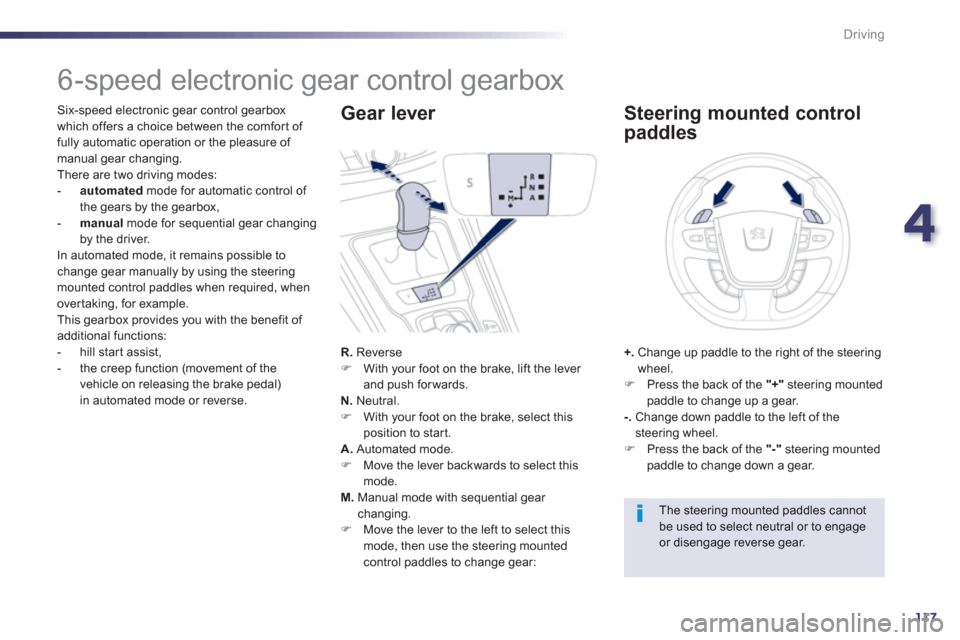
4
117
Driving
6-speed electronic gear control gearbox
Six-speed electronic gear control gearbox
which offers a choice between the comfort of
fully automatic operation or the pleasure of manual gear changing.
There are two driving modes: -automatedmode for automatic control of
the gears by the gearbox,
-
manualmode for sequential gear changing
by the driver.
In automated mode, it remains possible to
change gear manually by using the steering mounted control paddles when required, when
over taking, for example.
This gearbox provides you with the benefit of additional functions:
- hill star t assist,
- the creep function (movement of the
vehicle on releasing the brake pedal)
in automated mode or reverse.R
. ReverseFWith your foot on the brake, lift the lever
and push forwards.
N
.Neutral.FWith your foot on the brake, select this
position to start. A.
Automated mode. FMove the lever backwards to select this
mode. M.
Manual mode with sequential gear changing. FMove the lever to the left to select this
mode, then use the steering mounted control paddles to change gear:
Gear lever
+. Change up paddle to the right of the steeringwheel.F
Press the back of the "+"
steering mounted paddle to change up a gear. -.
Change down paddle to the left of thesteering wheel. F
Press the back of the "-"
steering mounted paddle to change down a gear.
Steering mounted control
paddles
The steering mounted paddles cannotbe used to select neutral or to engage or disengage reverse gear.
Page 148 of 340
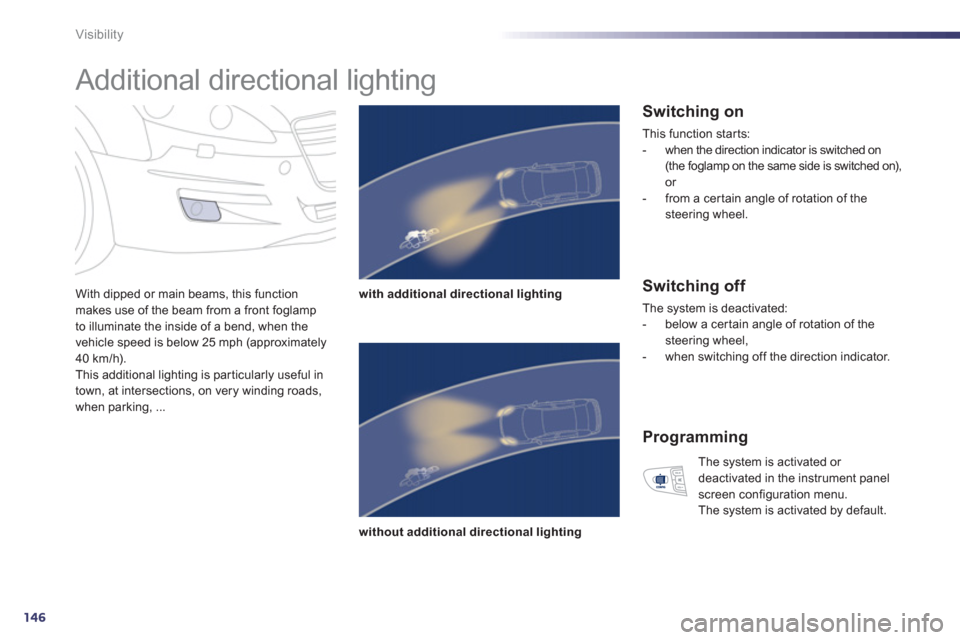
146
Visibility
Additional directional lighting
With dipped or main beams, this function makes use of the beam from a front foglamp
to illuminate the inside of a bend, when the
vehicle speed is below 25 mph (approximately40 km/h).
This additional lighting is par ticularly useful in
town, at intersections, on very winding roads,
when parking, ...with additional directional li
ghting
without additional directional lighting
Switching on
This function starts :
- when the direction indicator is switched on
(the foglamp on the same side is switched on),
or
- from a cer tain angle of rotation of the steering wheel.
Switching off
The system is deactivated:
- below a cer tain angle of rotation of thesteering wheel,
- when switching off the direction indicator.
Programming
The system is activated or
deactivated in the instrument panel
screen configuration menu.
The system is activated by default.
Page 168 of 340

166
Safety
Horn
F
Press the central part of the multifunction steering wheel.
Audible warning system to alert other road
users to an imminent dan
ger.
Use the horn moderately and only in the following circumstances:
- immediate danger,
- approaching a location lackingvisibility.
Emergency or
assistance call
This system allows you to make an emergencyor assistance call to the emergency services or
to the dedicated PEUGEOT ser vice.
For more information on the use of this function, refer to the "Audio andtelematics" section.
Page 169 of 340
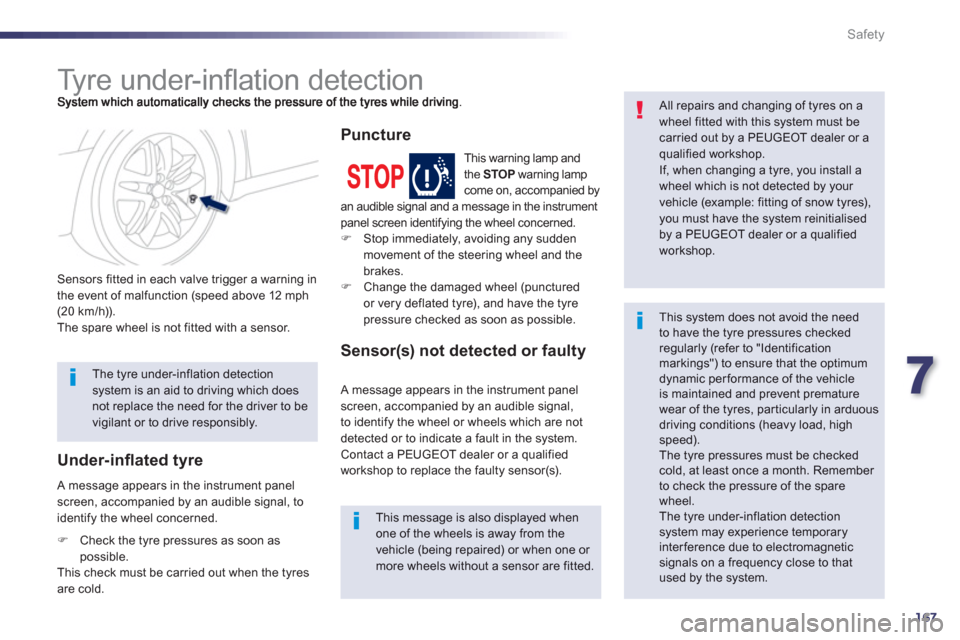
7
167
Safety
Ty r e u n d e r - i nfl ation detection
Sensors fitted in each valve trigger a warning in
the event of malfunction (speed above 12 mph (20 km/h)).
The spare wheel is not fitted with a sensor.
All repairs and changing of tyres on awheel fitted with this system must becarried out by a PEUGEOT dealer or a qualified workshop.
If, when changing a tyre, you install awheel which is not detected by your vehicle (example: fitting of snow tyres), you must have the system reinitialised
by a PEUGEOT dealer or a qualifiedworkshop.
This message is also displayed whenone of the wheels is away from thevehicle (being repaired) or when one or more wheels without a sensor are fitted.
The tyre under-inflation detectionsystem is an aid to driving which doesnot replace the need for the driver to bevigilant or to drive responsibly.
This system does not avoid the needto have the tyre pressures checkedregularly (refer to "Identification markings") to ensure that the optimumdynamic performance of the vehicleis maintained and prevent premature wear of the tyres, particularly in arduousdriving conditions (heavy load, highspeed). The tyre pressures must be checked cold, at least once a month. Remember to check the pressure of the spare wheel.
The tyre under-inflation detection system may experience temporary interference due to electromagnetic signals on a frequency close to that used by the system.
A message appears in the instrument panelscreen, accompanied by an audible signal, to
identify the wheel concerned.
Under-infl ated tyre
This warning lamp and
the STOPwarning lamp come on, accompanied by an audible signal and a message in the instrument panel screen identifying the wheel concerned. FStop immediately, avoiding any sudden
movement of the steering wheel and thebrakes.
FChange the damaged wheel (punctured
or very deflated tyre), and have the tyre
pressure checked as soon as possible.
Puncture
A message appears in the instrument panel
screen, accompanied by an audible signal,
to identify the wheel or wheels which are not
detected or to indicate a fault in the system.Contact a PEUGEOT dealer or a qualifiedworkshop to replace the faulty sensor(s).
Sensor(s) not detected or faulty
F
Check the tyre pressures as soon aspossible.
This check must be carried out when the tyres
are cold.
Page 176 of 340

174
Safety
Airbags
System designed to maximise the safety of the
occupants (with the exception of the rear centrepassenger) in the event of violent collisions.
It supplements the action of the force-limiting seat belts (with the exception of the rear centrepassenger).
If a collision occurs, the electronic detectors record and analyse the front and side impacts sustained in the impact detection zones:
- in the case of a serious impact, the airbagsare deployed instantly and protect the
occupants of the vehicle (with the exception
of the rear centre passenger); immediately after the impact, the airbags deflate rapidlyso that they do not hinder visibility or the
exit of the occupants,
- in the case of a minor or rear impact or incer tain roll-over conditions, the airbags
will not be deployed; the seat belt alone is
sufficient to provide optimum protection in
th
ese situations.
The airbags do not operate when the ignition is switched off. This equipment will only deploy once. If a second impact occurs (during thesame or a subsequent accident), theairbag will not be deployed again.
Deployment of the airbag(s) is accompanied by a slight emission of harmless smoke and a noise, due to theactivation of the pyrotechnic cartridgeincorporated in the system.This smoke is not harmful, but sensitiveindividuals may experience slight irritation. The noise of the detonation may result in a slight loss of hearing for a shorttime.
Impact detection zones
A.
Front impact zone. B.
Side impact zone.
Front airbags
Deployment
The airbags are deployed simultaneously, unless
the passenger's front airbag is deactivated, in the event of a serious front impact to all or part of thefront impact zone A , in the longitudinal centreline of
the vehicle on a horizontal plane and directed from
the front to the rear of the vehicle.
The front airbag inflates between the thorax and head of the front occupant of the vehicle and thesteering wheel, driver's side, and the dashboard,passenger's side to cushion their forward movement.
System which protects the driver and frontpassenger in the event of a serious front impact
in order to limit the risk of injury to the head and
thorax.
The driver's airbag is fitted in the centre of the steering wheel; the front passenger's airbag isfitted in the dashboard above the glove box.
Page 179 of 340
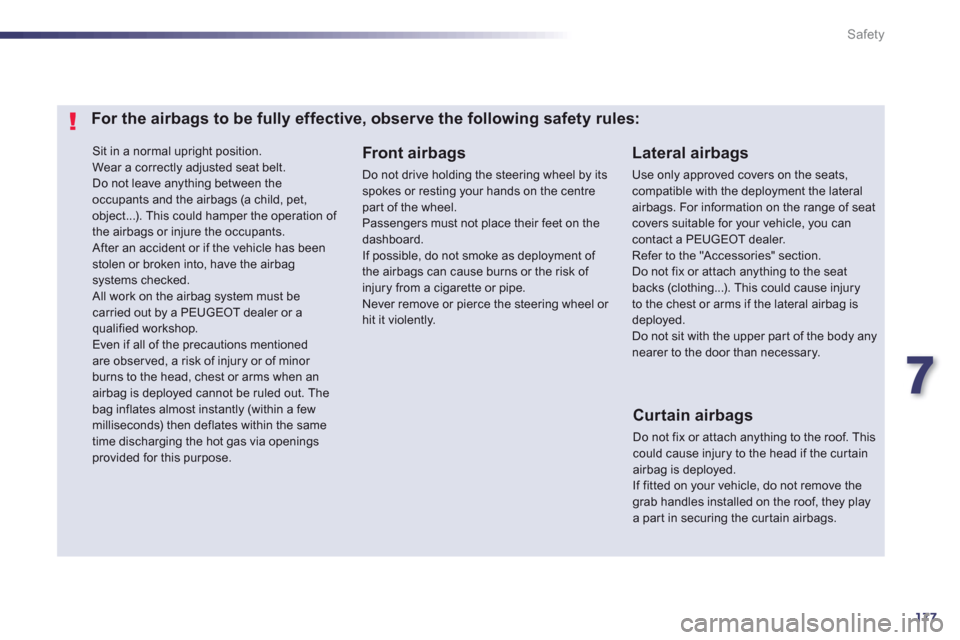
7
177
Safety
Sit in a normal upright position.
Wear a correctly adjusted seat belt.
Do not leave anything between theoccupants and the airbags (a child, pet, object...). This could hamper the operation of the airbags or injure the occupants. After an accident or if the vehicle has beenstolen or broken into, have the airbagsystems checked. All work on the airbag system must be carried out by a PEUGEOT dealer or a qualified workshop.
Even if all of the precautions mentionedare obser ved, a risk of injury or of minor burns to the head, chest or arms when an airbag is deployed cannot be ruled out. Thebag inflates almost instantly (within a fewmilliseconds) then deflates within the same
time discharging the hot gas via openings provided for this purpose.
Lateral airbags
Use only approved covers on the seats, compatible with the deployment the lateralairbags. For information on the range of seatcovers suitable for your vehicle, you can contact a PEUGEOT dealer. Refer to the "Accessories" section.Do not fix or attach anything to the seatbacks (clothing...). This could cause injuryto the chest or arms if the lateral airbag isdeployed.Do not sit with the upper par t of the body anynearer to the door than necessary.
Front airbags
Do not drive holding the steering wheel by itsspokes or resting your hands on the centre part of the wheel.
Passengers must not place their feet on thedashboard.
If possible, do not smoke as deployment of the airbags can cause burns or the risk of injury from a cigarette or pipe.
Never remove or pierce the steering wheel or hit it violently.
For the airbags to be fully effective, observe the following safety rules:
Curtain airbags
Do not fix or attach anything to the roof. This could cause injury to the head if the cur tain airbag is deployed. If fitted on your vehicle, do not remove thegrab handles installed on the roof, they play a part in securing the cur tain airbags.
Page 181 of 340
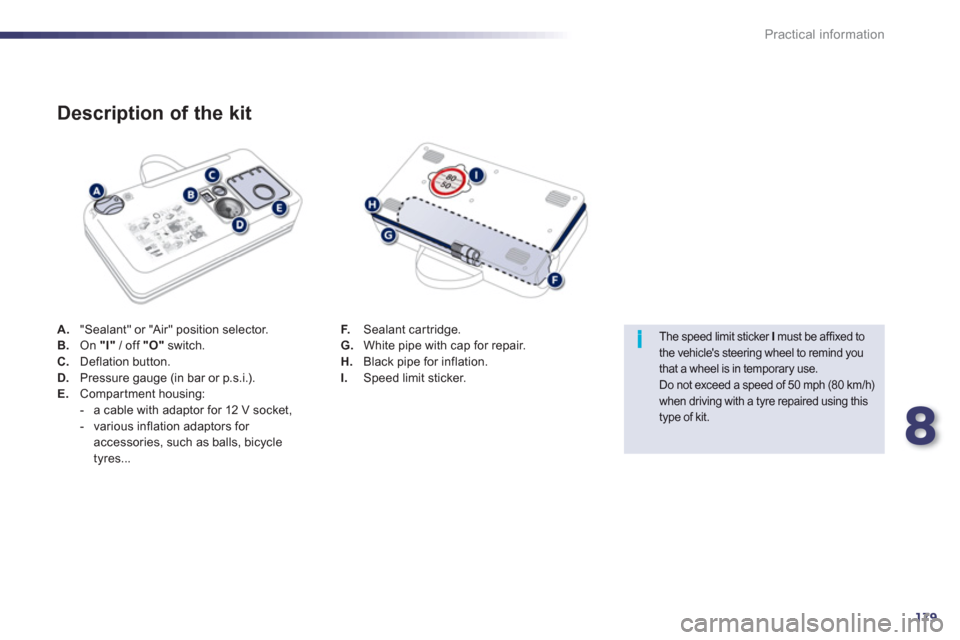
8
179
i
Practical information
A."Sealant" or "Air" position selector.
B.On "I"/ off "O"switch. C.Deflation button.D.Pressure gauge (in bar or p.s.i.). E.
Compartment housing:
- a cable with adaptor for 12 V socket,
- various inflation adaptors for accessories, such as balls, bicycle
tyres...
Description of the kit
F.
Sealant car tridge.G.
White pipe with cap for repair. H.Black pipe for inflation.I.Speed limit sticker.
The speed limit sticker I
must be affixed to the vehicle's steering wheel to remind you that a wheel is in temporary use. Do not exceed a speed of 50 mph (80 km/h) when driving with a tyre repaired using this type of kit.